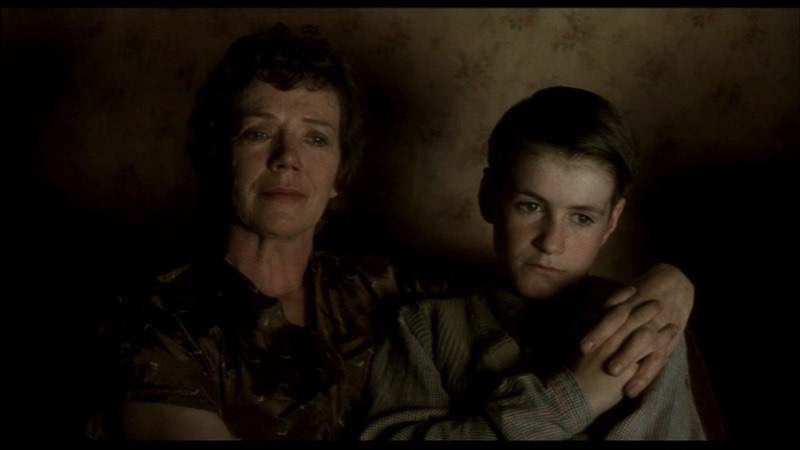Bud waits in a queue for a school nurse to check his head for lice. Her affect is flat as she inspects the heads of pre-teen boys and sends them on their way. A few scenes later, Bud’s mother rubs his shampooed head with a towel. He complains of the burning and wants nothing more than to get up from his chair.
There’s nothing exceptional about the moment, and Davies — a poet of a filmmaker — doesn’t deal in the major episodes that make up a life. He narrows in on the fleeting moments, seemingly insignificant but nonetheless rich happenings that push his audiences inwards.
—
In his 77 years, Davies career was profound but not as prolific as it could have been. While he struggled to secure financing for many of his projects, each one of his eight films are wholly original, all intimate portraits of human struggle. He was also gay. I wouldn’t call him a “gay filmmaker,” but outcasts, in some form or another, are often our way into his movies.
Some of my favorites include his debut Distant Voices, Still Lives (1988), another autobiographical work that has a fable-like quality to it as it documents chapter’s in a family’s life in 1940s and 1950s Liverpool. There’s House of Mirth (2000), an Edith Wharton adaptation that is just about as upsetting as anything I’ve ever seen. His last two films, about the poets Emily Dickinson (A Quiet Passion) and Sigfried Sassoon (Benediction) feel like the type of movies a visionary makes at the end of a life. Both figures struggled to comprehend the end. In A Quiet Passion, Dickinson flirts with death as it take away the people she loves before it ravages her body and claims her. Sassoon’s struggle is more global, as he looks to faith in an attempt to grasp the banality of existence in the face of WWI.
Davies also had an incredible wit, and the dialogue in his films is often heightened. Language is as important as anything else—music, performance, a single frame— especially when it’s used as a tool for avoidance. I think about Benediction a lot, the gay cattiness of the men in the film, and know— the way we all know—why humor is the ultimate defense mechanism. At some point Sassoon, in his older age, says, “We are unique only to the people who really loathe us.” It’s one of many acidic declarations, and I think about it a lot.
But I want to focus on The Long Day Closes. I rewatched it the night after I learned of Davies’s passing, and it continues to be one of the more soul-stirring movies I’ve ever seen.
—
One of the earliest shots sees Bud looking out a window, onto the streets of Liverpool. His gaze rests on a sweaty, shirtless man applying mortar to brick. The man flashes him a smile and a wink, and Bud’s face shifts to something of discomfort. He’s not ready to interrogate what this stirs up in him. For now, Davies lets it be a simple curiosity.
In his own semi-autobiographical film, Pedro Almodovar has his young surrogate experience something similar. Even though he’s just a child, he’s tasked with teaching a young, handsome man in his small Spanish village how to read and write. Then one day, he sees him undressed and it sparks something. But again, it’s just a little occurrence, not something to probe at yet.
I think of this scene and so many other in The Long Day Closes as little revelations. They create a tightness in my chest. Bud is loved by his mother and older siblings, but even though he’s enveloped by their warmth and protection, Davies paints him as plagued by a distinct melancholy. It’s a burden to be curious, and as our introduction to him shows, it’s often the people who are looking out into the world, observing others, that suffer.
Bud’s school/religious life is of note. It’s a place of rigidity and discipline. Uniformity is prized above all else. He’s frequently in trouble, and it’s difficult not to imagine Davies here, reminiscing about the times when our earliest mentors attempted to do everything in their power to crush our individuality. For every moment of bliss, often explored through music—his mother singing, renditions of Nat King Cole classics—there’s a sense of suffocation.
What hits me so hard is that the pain of youth is something one can only process in time. I think about a common practice in therapy. A therapist will ask you to close your eyes and look back to a younger version of yourself, when you were innocent, unaware, and helpless. They’ll then say to imagine giving this younger version of yourself a hug, to imagine being the protector you never had. The Long Day Closes isn’t exactly a hug, but it is an attempt to reconcile what one someone once was and what they’ve now become.
The Long Day Closes also makes me think of anything autobiographical I’ve ever tried to write. It’s an impossible task, and anyone who tells you any different is a liar (or will probably write something that only scratches the surface). You need to master your relationship to time, create a sort of distance in order to see yourself and your experiences. You also have to realize that memory, or a true memory film, is not something that can be expressed linearly. Almost like dream logic, we remember pieces of our past. Events that may have been huge are hard to recall, but sometimes the littlest things linger: the way light hit a piece of furniture, being the last one up on Christmas Eve, a lice check.
This was Terence Davies, and if I can accomplish anything half as intimate as he did, I’d be so lucky.




